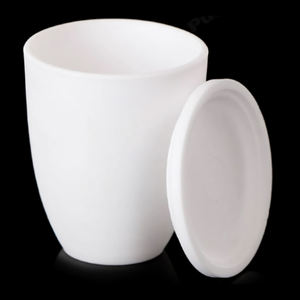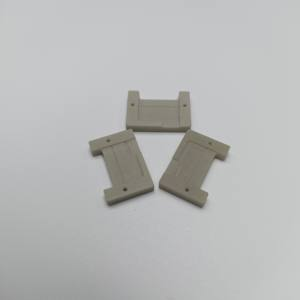Discover Premium Ceramic Products | Durability & Elegance United | Advanced Ceramics
1. Introduction
Just 24 hours ago, industry giant Wolfspeed announced a major expansion of its silicon carbide wafer production facility in North Carolina, citing surging global demand for EV power semiconductors. At the heart of this expansion lies a seemingly humble but technologically vital component: the silicon carbide crucible. While most associate silicon carbide with abrasives or armor, its use in high-purity crystal growth is transforming the semiconductor supply chain—and it’s happening right now.

In this article, we’ll dive into how silicon carbide crucibles enable the production of ultra-pure silicon crystals for next-generation power devices, why they’re preferred over alternatives like boron carbide or silicon nitride, and how this niche application is quietly powering the electric vehicle revolution.
2. Why Crystal Growth Demands Extreme Materials
Growing semiconductor-grade silicon crystals—especially for silicon carbide (SiC) wafers themselves—requires temperatures exceeding 2,000°C in chemically aggressive, oxygen-free environments. Standard graphite or alumina crucibles degrade too quickly or contaminate the melt. That’s where the silicon carbide crucible shines.
Silicon carbide offers exceptional thermal conductivity, mechanical strength at high temperatures, and chemical inertness. Crucibles made from high-purity reaction-bonded silicon carbide (RBSiC) can withstand repeated thermal cycling without cracking or leaching impurities—critical for maintaining the crystal’s electronic properties.
3. Silicon Carbide vs. Alternatives in High-Temperature Crucibles
3.1. Boron Carbide vs Silicon Carbide

While boron carbide is harder and used in armor, it’s far more expensive and less thermally conductive than silicon carbide. In crucible applications, boron carbide can react with molten silicon, introducing unwanted dopants. Silicon carbide remains chemically stable, making it the clear choice for purity-sensitive processes.
3.2. Silicon Nitride Crucibles: A Niche Contender
Silicon nitride ceramic crucibles—often sourced from specialized silicon nitride crucible factories—excel in thermal shock resistance. However, they’re more brittle and costly to produce at scale. For large-diameter crystal growth (common in EV inverter chips), silicon carbide crucibles offer better durability and cost efficiency.
4. Real-World Application: Growing 6-Inch and 8-Inch SiC Ingots
Modern SiC wafer production uses the Physical Vapor Transport (PVT) method, where silicon carbide powder sublimates in a sealed crucible and re-crystallizes on a seed crystal. The crucible must maintain structural integrity while resisting erosion from silicon vapor.
Here, RBSiC silicon carbide tile blocks are often machined into custom crucible shapes. Their near-net-shape capability reduces waste and ensures uniform thermal profiles—key for minimizing crystal defects. Even components like silicon carbide rings and silicon carbide ceramic columns are used as internal fixtures to guide vapor flow.

5. Beyond the Crucible: Supporting High-Temp Infrastructure
The entire furnace ecosystem relies on silicon carbide’s robustness. Silicon carbide thermocouple protection tubes shield sensors from corrosive atmospheres. Silicon carbide ceramic tubes for furnace use act as insulation liners. Even silicon carbide burner nozzles and silicon carbide bricks line the heating chambers.
Meanwhile, silicon carbide porous ceramic tubes may be used in gas filtration systems to maintain ultra-clean argon or nitrogen atmospheres—another layer of contamination control.
6. Misconceptions: Not All Silicon Carbide Is for Dinnerware
A quick online search reveals dozens of consumer products labeled ‘silicon carbide ceramic baking dish,’ ‘silicon carbide ceramic dinner plates,’ or ‘silicon carbide ceramic serving bowls.’ While silicon carbide is indeed used in some high-end cookware for its heat retention, these are distinct from the ultra-high-purity, sintered forms used in semiconductor manufacturing.
Industrial silicon carbide crucibles contain minimal additives and undergo rigorous purity testing—unlike decorative items like silicon carbide blue white porcelain plates or silicon carbide christmas ceramic platters. Confusing the two could lead to serious process failures in crystal growth.
7. Future Outlook and Market Shifts
With the high purity silicon nitride powder market growing alongside SiC adoption, material science is advancing rapidly. Yet, for large-scale, cost-effective crystal growth, silicon carbide crucibles remain unmatched. Innovations in RBSiC manufacturing and recycling of used crucibles are further driving down costs.
As automakers like Tesla and BYD double down on SiC-based inverters for longer range and faster charging, demand for reliable silicon carbide crucibles will only intensify.
8. Conclusion
From silicon carbide ceramic tubes to custom crucibles, this advanced ceramic is the unsung hero of the semiconductor renaissance. Its unique blend of thermal, chemical, and mechanical properties makes it indispensable in producing the chips that power our electric future—proving that sometimes, the most transformative technologies start in a crucible.
Our Website founded on October 17, 2012, is a high-tech enterprise committed to the research and development, production, processing, sales and technical services of ceramic relative materials such as Silicon. Our products includes but not limited to Boron Carbide Ceramic Products, Boron Nitride Ceramic Products, Silicon Carbide Ceramic Products, Silicon Nitride Ceramic Products, Zirconium Dioxide Ceramic Products, etc. If you are interested, please feel free to contact us.

